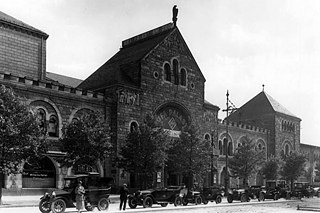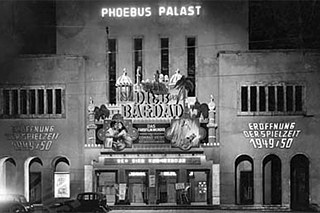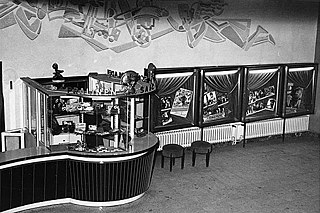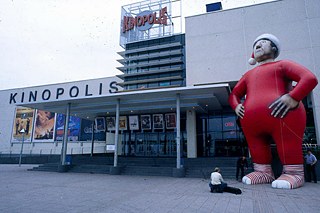Cinema History in Germany
From Kintopp to Multiplex

The Skladanowsky brothers screened the first films in Germany 120 years ago – 1895 in the ballroom of a restaurant popular with day-trippers in Berlin’s Pankow district. Since then, the venues in which we view films have changed constantly.
1895 saw the dawn of cinema around the world – in Germany, too. “Feldschlößchen”, a restaurant in the Pankow district of Berlin, served as the country’s first cinema: it was here that Max and Emil Skladanowsky used their “Bioskop” film projector in July to show their first short homemade film sequences to a select audience. A successful test run was followed by regular public screenings: from 1 November, curious visitors to the Wintergarten in Berlin could gape at the Skladanowskys’ moving pictures – the highlight at the end of a classic music hall show.
From “cinema of attractions” to picture house
In the early years of cinema there were neither fixed narrative forms nor venues. The fascination derived from the novelty of flickering moving pictures was enough in itself to draw audiences to small theatre venues and funfairs, where travelling projectionists would present short films as a spectacle. This “cinema of attractions”, as US film historian Tom Gunning termed it, was the dominant form of the young medium, shaping the way films were experienced right up to the first decade of the twentieth century.Its enormous popularity then gave rise to the first dedicated cinemas. These initially small and fairly unimpressive buildings with beer on tap were soon expanded, however. In 1912, the Kammerlichtspiele cinema opened in the magnificent Haus Vaterland at Potsdamer Platz in Berlin; its theatre could already seat audiences of 1,200. This cinema was the predecessor of the increasingly opulent film palaces which took pride of place in city centre locations.
Mass entertainment and dominant medium
The “Kintopp”, as cinema was known in Germany in its early days, became a place where all kinds of social groups of any age could come together. Its attraction remained undiminished for decades. Towards the end of the 1920s, more than 5,000 German picture houses attracted over 350 million cinema-goers each year. The Nazis attempted to exploit the power of cinemas to reach the masses for their own ends. In the last years of the Second World War, the propaganda-tinged programmes of information and entertainment, among them the first colour films, drew audiences of over a billion to german cinemas.By the time the Second World War came to an end, many of the glitzy film palaces lay in ruins. As in the early years of cinema, all kinds of venues were converted for cinema screenings and used by the Allies to “re-educate” (Note: The aim of re-education was to “denazify” the German population) people through film. Renewed investment was then made thanks to West Germany’s economic miracle: elegant cinemas were built which would screen premieres and give audiences the chance to experience stars up close and personal. Offering the added bonus of newsreels and cultural films, a visit to the cinema became a popular leisure pursuit that the entire family could enjoy together.
The death of cinema and diversification
Soon afterwards, however, the introduction of television in the late 1950s had a devastating impact on cinemas, causing audience numbers to plummet. Many cinemas were forced to close, among them not only small picture houses in rural areas but also big city cinemas that were facing tough competition. To combat the slump in box office sales, monumental films in glorious colour were increasingly produced in an attempt to make the black-and-white television programmes appear pale by comparison.At the same time, ever more diverse audiences provided more and more niche opportunities. To cater to all these changed tastes, the 1970s saw many large theatres divided up into lots of “shoebox cinemas”. As a backlash to commercial cinema, self-governed community cinemas (known as “KoKis”) were also established in many places and showed an independent programme. The success of the video cassette in the 1980s revealed that specializing in a particular niche was not enough in itself to ensure security, however: it spelt the end for many seedy railway station cinemas where action thrillers and porno films were screened.
The rise of the multiplex
The cinema market became increasingly consolidated, and the early 1990s saw the first American-style multiplex cinemas open in German cities. They offered a number of large, high-tech theatres designed for optimal viewing, all under one roof. The programme always featured the latest blockbusters and was aimed at generally younger audiences who flocked to the spacious if somewhat functional cinema complexes in their droves. The multiplexes, which tended to be operated as chains, forced many owner-run cinemas to close. At the same time, however, the new standards they set generated a generally increased interest in cinema.Premium cinemas and high-tech of the future
A trend in recent years towards premium cinemas with lovingly restored or lavishly designed new theatres, in which drinks are served at the audience’s seats, shows however that many people want a visit to the cinema to be more than simply watching a perfectly screened film. In contrast to the homogenous multiplexes, the focus here is on the cinema theatre itself – which consciously reflects the glamour of the picture houses of a bygone era.At the same time, the revolution in digital film technology, with which even the smallest cinemas are equipped nowadays, continues: the next generation of cinema will use high-contrast laser projection to achieve unparalleled black-and-white tones. There will be darkness as black as the deepest night, and audiences will be blinded by the sun rising on the screen. To this end, the theatres will have to be turned into entirely black boxes so that no stray light detracts from the viewing of the film. The experience of the cinema theatre itself will move into the background.
















